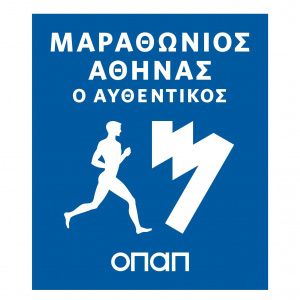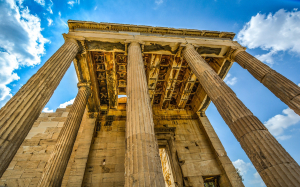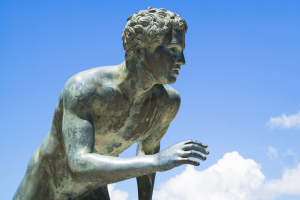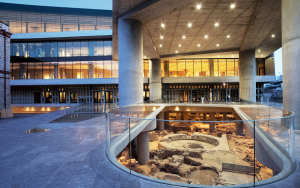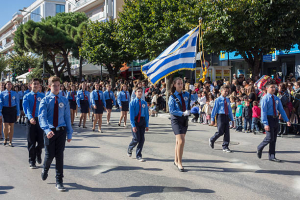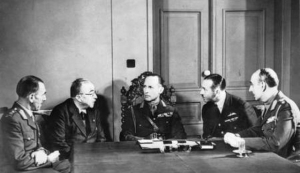ABOUT US
XpatAthens
Saturday, 05 November 2022 17:00
Athens Marathon. The Authentic
The 39th Athens Marathon. The Authentic’ will be held on 12-13 November 2022 by the Hellenic Athletics Federation (SEGAS) with the support & sponsorship of the state as well as the private sector.
This year’s race will accept even more runners than the 2021 race, which was limited due to the pandemic. A total of 15,000 entries will open for the Marathon Race, 15,000 for the 5km Road Race and 12,000 for the 10km Road Race.
For the first time this year, the Universities Night Run will take place on Saturday 12 November, with a participation limit of 3,000 people. All the activities of this race, as well as the international conference that SEGAS is preparing, will be presented in detail in the coming weeks.
This year, the 1,2km Kids’ Race returns to the program of the event, in which 900 children will participate.
Published in
Sports & Wellness
Tagged under
Thursday, 03 November 2022 07:00
Greece World Champion In Improving Business Environment
Greece has become the top country in the world in improving the business environment over the last few years, a report by the Economist Intelligence Unit (EIU) found recently.
Compared with the fourth quarter of 2019, Greece’s business environment ranking (BER) increased by 16 places, the report says.
“This significant improvement reflects its poor starting point, given a long-delayed recovery from the government debt crisis that began in 2009, but also the impact of a pro-business majority government that has undertaken reforms, cut taxes, and restored confidence in the country,” the EIU adds.
Greek Prime Minister Kyriakos Mitsotakis hailed the report's findings, saying that it is very encouraging to see our efforts to reform the economy recognized.
The business environment in Greece was aided by “reforms, tax cuts
Chief economic adviser to the Prime Minister of Greece, Alexis Patelis said that the significant improvement reflects its poor starting point, but also the impact of a pro-business majority government that has undertaken reforms, cut taxes, and restored confidence in the country.
The EIU report says the most significant improvements over the past three years since before the ructions caused by the pandemic and the war in Ukraine, are in the business environments of Greece, Qatar, the US, and the UAE. The biggest deteriorations are in Latin America, the lowest-ranking region, as well as in Russia and Ukraine.
To read this article in full, please visit: greekreporter.com
Compared with the fourth quarter of 2019, Greece’s business environment ranking (BER) increased by 16 places, the report says.
“This significant improvement reflects its poor starting point, given a long-delayed recovery from the government debt crisis that began in 2009, but also the impact of a pro-business majority government that has undertaken reforms, cut taxes, and restored confidence in the country,” the EIU adds.
Greek Prime Minister Kyriakos Mitsotakis hailed the report's findings, saying that it is very encouraging to see our efforts to reform the economy recognized.
The business environment in Greece was aided by “reforms, tax cuts
Chief economic adviser to the Prime Minister of Greece, Alexis Patelis said that the significant improvement reflects its poor starting point, but also the impact of a pro-business majority government that has undertaken reforms, cut taxes, and restored confidence in the country.
The EIU report says the most significant improvements over the past three years since before the ructions caused by the pandemic and the war in Ukraine, are in the business environments of Greece, Qatar, the US, and the UAE. The biggest deteriorations are in Latin America, the lowest-ranking region, as well as in Russia and Ukraine.
To read this article in full, please visit: greekreporter.com
Published in
Business News
Tagged under
Tuesday, 01 November 2022 07:00
7 Mysteries Of Ancient Greece That Remain Unexplained
Ancient Greece was the birthplace of Western civilization and democracy. The information we have about the life of the ancient Greeks, their celebrations, and their religious beliefs has been preserved in a series of ancient texts, which have survived, and today are part of the world's cultural heritage.
Despite our extensive knowledge about life in Ancient Greece, there are some mysteries that remain unexplained.
The Eleusinian Mysteries
The Eleusinian Mysteries were the most sacred religious rites of ancient Greece, practiced for over a thousand years. Yet, we do not have much information about the rituals during these initiations. The people who participated in the Eleusinian Mysteries could not reveal what was going on during them. Several scientists claim, in fact, that anyone who spoke about the rituals was in danger of losing his life.
The First (?) Actor
Many claim that the first actor in history was none other than Thespis. More specifically, Thespis is believed to have been the first to combine choral singing with recitations and was the first to exchange words with the chorus leader (coryphaeus). However, many argue that this particular person was a myth, a symbol of the beginning of acting in the Greek theatrical tradition.
The Architecture of the Parthenon
The Parthenon is considered one of the most emblematic temples of the ancient world. And books upon books may have been written about its construction, but there are some aspects of it that still remain unknown. There are questions to this day about the "figures" depicted on the frieze, as well as the two inner chambers that existed within the temple, since no one has determined with absolute certainty what they were used for.
The Works of Pythagoras
We all know him for the famous Pythagorean Theorem. However, the life and work of the mathematician who created it are obscure. This is partly due to the fact that the philosophical school he founded operated in extreme secrecy. Also, many point out that his famous theory was first developed in ancient Babylon.
The Destruction of the Statue of Zeus
It is one of the seven wonders of the ancient world. Of these, only the Great Pyramid of Giza in Egypt survives today. The statue of Zeus was created by Pheidias, and its destruction remains a great mystery. Legend has it that it was destroyed by fire, with the statue reduced to ashes. It has been argued, however, that the huge statue was removed from the temple and moved to Constantinople, where it was later destroyed.
The Mythical Labyrinth of the Minotaur
The Minotaur was a mythical creature with the body of a man and the head of a bull, who was kept imprisoned in a labyrinth by the king of Crete, Minos. The labyrinth is believed to have existed in the palace of the ancient city of Knossos. The excavations that have been conducted in the area, however, have not revealed any building structures that match a maze. Therefore, the debate surrounding the famous labyrinth continues to this day.
The Works of Homer
Homer is considered the greatest poet of all time. However, he remains a mysterious figure of Ancient Greece in many ways since several analysts argue that he was not the real—or, at least not the only—creator of the Iliad and the Odyssey. In any case, the information we have about him is much less than we would like. As for the two epic poems? It would be more proper to view Homer as the culmination of a tradition, the top of a centuries-old poetic pyramid, instead of the sole poet of these two works.
Originally published in Greek on: oneman.gr
Originally published in Greek on: oneman.gr
Translated by: Codico Lab
Published in
Greek Philosophy & History
Tagged under
Monday, 31 October 2022 07:00
What Did The Ancient Greeks Look Like?
More than most other populations from the ancient past, the physical appearance of the Greeks, especially those of the Classical period of the 5th and 4th centuries BC, has been a source of fascination for scholars, poets, artists, and political leaders (oftentimes nefariously), for centuries.
To put everyone at ease from the start, evidence strongly suggests that modern Greeks are genetically similar to those who inhabited these lands 2,500 years ago. Thanks to recent DNA studies of ancient human remains, we now know that today’s Greeks share a “genetic overlap” with even earlier populations in the region, being closely related to the Bronze Age Mycenaeans (ca. 1600-1200 BC) and, even further back in time, to the migrant Neolithic farmers who first ventured across the Aegean from Anatolia in the 7th and 6th millennia BC.
It’s safe to say that when we think of the descendants of the ancient Greeks, we needn’t go any further than the modern population. But beyond the typical Mediterranean stereotype of dark hair, brown eyes, and olive skin that we often associate with people of Greek descent, we also know that modern Greeks are quite diverse in appearance, including those with much fairer coloring (blue and green eyes, blond hair and even the occasional redhead), and others who are much darker in complexion.
Ancient Greeks In Art
Minoan frescoes (the art of painting on plastered walls) from the mid-second millennium BC, notably from Crete and Santorini – the famous wall paintings of Thera, for example – make clear distinctions between male and female figures. Tall and slender, with narrow waists and long, dark hair, men are often depicted with reddish-brown skin, while women appear as porcelain white, with piercing kohl-rimmed eyes, and with fuller figures. This artistic convention is similar to the depiction of men and women in ancient Egyptian frescoes. In reality, Minoan women likely applied a foundation of toxic white lead or carbonate to lighten their complexion, a practice that was widely used by aristocratic women in late 16th through 18th century Europe (e.g., Queen Elizabeth I of England).
Finely painted ceramic vessels from the mid-first millennium BC, especially during the later Archaic and Classical periods (ca. 600-323 BC), provide key insight into aspects of everyday life, offering some interesting clues about the physical characteristics of everyday people. Both men and women are usually depicted with low foreheads, thick curly hair, almost always black or dark brown, straight noses, large eyes, and ovoid faces. The bi-chromatic nature of the art (both in black-figure and the later red-figure traditions) makes it difficult to determine skin coloring, but the white-ground technique, developed in Attica ca. 500 BC, gave artists more freedom to express colors. In a similar fashion to earlier Bronze Age art, women often appear as fair-skinned while men often appear in darker hues or completely black.
Human Remains
A recent Harvard University study analyzed the ancient DNA extracted from the teeth of 19 people, including 10 Minoans from Crete (dating from 2900-1700 BC), four Mycenaeans from the Greek mainland (1700-1200 BC), and five individuals from other Bronze Age or early farming (Early Neolithic) communities (5400-1340 BC). It was found that the Minoans and Mycenaeans were closely related to each other, inheriting three-quarters of their DNA from the earlier farmers who had migrated across from Anatolia (modern-day Turkey). Crucially, the Mycenaeans were found to have as much as 16 percent of their DNA from the Eurasian Steppe and/or Armenia, indicating a genetic divergence from their Minoan cousins. It appears that these northern ancestors didn’t make it as far south as Crete.
When compared to the DNA of modern Greeks, it was found there is a close “genetic overlap” with the ancient Mycenaeans, sharing many of the same ancestral roots but with some additional dilution of the earlier Neolithic ancestry. Remarking on the continuity of the modern population with their Late Bronze Age forebears, co-author George Stamatoyannopoulos of the University of Washington in Seattle, said it’s “particularly striking given that the Aegean has been a crossroads of civilizations for thousands of years.” While modern Greeks have acquired further genetic traits from later migrations, it’s no surprise that the genes for dark hair and brown eyes, carried over from the Minoans and Mycenaeans, remain so dominant today.
To read this article in full, please visit: greece-is.com
To put everyone at ease from the start, evidence strongly suggests that modern Greeks are genetically similar to those who inhabited these lands 2,500 years ago. Thanks to recent DNA studies of ancient human remains, we now know that today’s Greeks share a “genetic overlap” with even earlier populations in the region, being closely related to the Bronze Age Mycenaeans (ca. 1600-1200 BC) and, even further back in time, to the migrant Neolithic farmers who first ventured across the Aegean from Anatolia in the 7th and 6th millennia BC.
It’s safe to say that when we think of the descendants of the ancient Greeks, we needn’t go any further than the modern population. But beyond the typical Mediterranean stereotype of dark hair, brown eyes, and olive skin that we often associate with people of Greek descent, we also know that modern Greeks are quite diverse in appearance, including those with much fairer coloring (blue and green eyes, blond hair and even the occasional redhead), and others who are much darker in complexion.
Ancient Greeks In Art
Minoan frescoes (the art of painting on plastered walls) from the mid-second millennium BC, notably from Crete and Santorini – the famous wall paintings of Thera, for example – make clear distinctions between male and female figures. Tall and slender, with narrow waists and long, dark hair, men are often depicted with reddish-brown skin, while women appear as porcelain white, with piercing kohl-rimmed eyes, and with fuller figures. This artistic convention is similar to the depiction of men and women in ancient Egyptian frescoes. In reality, Minoan women likely applied a foundation of toxic white lead or carbonate to lighten their complexion, a practice that was widely used by aristocratic women in late 16th through 18th century Europe (e.g., Queen Elizabeth I of England).
Finely painted ceramic vessels from the mid-first millennium BC, especially during the later Archaic and Classical periods (ca. 600-323 BC), provide key insight into aspects of everyday life, offering some interesting clues about the physical characteristics of everyday people. Both men and women are usually depicted with low foreheads, thick curly hair, almost always black or dark brown, straight noses, large eyes, and ovoid faces. The bi-chromatic nature of the art (both in black-figure and the later red-figure traditions) makes it difficult to determine skin coloring, but the white-ground technique, developed in Attica ca. 500 BC, gave artists more freedom to express colors. In a similar fashion to earlier Bronze Age art, women often appear as fair-skinned while men often appear in darker hues or completely black.
Human Remains
A recent Harvard University study analyzed the ancient DNA extracted from the teeth of 19 people, including 10 Minoans from Crete (dating from 2900-1700 BC), four Mycenaeans from the Greek mainland (1700-1200 BC), and five individuals from other Bronze Age or early farming (Early Neolithic) communities (5400-1340 BC). It was found that the Minoans and Mycenaeans were closely related to each other, inheriting three-quarters of their DNA from the earlier farmers who had migrated across from Anatolia (modern-day Turkey). Crucially, the Mycenaeans were found to have as much as 16 percent of their DNA from the Eurasian Steppe and/or Armenia, indicating a genetic divergence from their Minoan cousins. It appears that these northern ancestors didn’t make it as far south as Crete.
When compared to the DNA of modern Greeks, it was found there is a close “genetic overlap” with the ancient Mycenaeans, sharing many of the same ancestral roots but with some additional dilution of the earlier Neolithic ancestry. Remarking on the continuity of the modern population with their Late Bronze Age forebears, co-author George Stamatoyannopoulos of the University of Washington in Seattle, said it’s “particularly striking given that the Aegean has been a crossroads of civilizations for thousands of years.” While modern Greeks have acquired further genetic traits from later migrations, it’s no surprise that the genes for dark hair and brown eyes, carried over from the Minoans and Mycenaeans, remain so dominant today.
To read this article in full, please visit: greece-is.com
Published in
Greek Philosophy & History
Tagged under
Wednesday, 22 March 2023 13:14
Andrea Bocelli Live In Athens
For the FIRST TIME, the most beloved tenor on the planet, the artist-legend Andrea Bocelli, the man who gave new life to opera, will appear on July 18, 2023 at the Olympic Stadium in Athens, offering a unique opportunity for visitors to enjoy and be enchanted from his voice, his ethos and his temperamental setting.
The singer with the evocative voice, breaking all records for sold-out concerts around the world, the most famous tenor of his generation, and one of the most important artists of all time, returns to Athens on July 18, 2023 to perform in the biggest concert of Greece, until today!
A unique, magical experience for all music lovers.
The singer with the evocative voice, breaking all records for sold-out concerts around the world, the most famous tenor of his generation, and one of the most important artists of all time, returns to Athens on July 18, 2023 to perform in the biggest concert of Greece, until today!
A unique, magical experience for all music lovers.
Published in
Music
Tagged under
Wednesday, 26 October 2022 12:20
Free Admission To The Acropolis Museum On October 28th
On Friday, October 28th admission to the Acropolis Museum will be free from 08:00 am until 22:00 pm.
Just like every other Friday, the museum's restaurant on the second floor will be open until midnight.
Just like every other Friday, the museum's restaurant on the second floor will be open until midnight.
Published in
Community
Tagged under
Wednesday, 26 October 2022 07:00
5 Interesting Facts About Ohi Day You May Don’t Know
Ohi Day is commemorated each year on October 28th by Greeks throughout the world and is undeniably one of the proudest moments in Greek history. It was the day when Ioannis Metaxas, on behalf of the Greek people, bravely shouted “No” and resisted the Italian occupation.
Here are five lesser-known facts regarding Ohi Day you may haven’t heard of!
Metaxas didn’t actually say “No”
When Grazzi delivered Benito Mussolini's message asking that the Italian forces be allowed into Greek territory, the Greek general responded in French. He famously said, "Alors, c’est la guerre." (Well, this means war). A newspaper called the Greek Future was the reason why the word “Ohi” was associated with this day. In its issue of October 30, 1940, the newspaper coined the word “Ohi” on the front page title of the article reporting the events.
The fascist orientation of Ioannis Metaxas
Fascism had a certain appeal for Ioannis Metaxas long before he became a dictator in 1936, and his "4th of August" regime had similarities with the fascist regimes of Italy and Germany. He didn't dream of a fascist Greece though; what he wanted to achieve was “The Third Hellenic Civilisation”, an unspecified concept for which we still do not have enough information. However, he understood well enough that the country’s interests lay with Great Britain and tried not to join the war until he didn’t have a choice.
Famous Greek artists fought in the war
Poet Odysseas Elytis might be among the most famous Greek artists who fought in the Greco-Italian War, an experience that inspired some of his works, including Axion Esti. Other artists who served as soldiers include painters Yannis Tsarouchis, Spyros Vasileiou, and Aleksandros Aleksandrakis; writers Nikiforos Vrettakos, Aggelos Terzakis, and Yorgos Theotokas; and beloved comedy actors Lampros Konstantaras, Dyonisis Papagiannopoulos, and Ntinos Iliopoulos.
Greece was the first nation to win a battle against Axis powers
At first, it may seem weird that we “celebrate” the beginning of the war instead of the end of it, but it is not: only Greece could celebrate the beginning of the war since it was the only country that managed to defeat the enemy during this first phase of the war. In fact, it was the first victory of the allied forces that revitalized the morale of all allies since, until then, there had only been defeats.
Metaxas’ guard mistook Grazzi for the French ambassador
Although there is nothing fun about war, we could say that this one is quite a “fun fact” about Ohi Day. When Italy’s ambassador, Emanuele Grazzi, arrived at Metaxas’ residence in Kifisia, it was 3 a.m. As reported, one of the guards mistook the Italian flag on Grazzi’s car for a French one. Hence, Metaxas originally woke up thinking he should urgently meet the French ambassador.
Published in
Greek Philosophy & History
Tagged under
Tuesday, 25 October 2022 07:00
Greek Monastery Manuscripts Tell New Story Of Ottoman Rule
A church bell sounds, the staccato thudding of mallet on plank summons monks to afternoon prayers, and deep voices are raised in communal chant. And high in the great tower of Pantokrator Monastery, a metal library door swings open.
There, deep inside the medieval fortified monastery in the Mount Athos monastic Orthodox Christian community, researchers are for the first time tapping a virtually unknown treasure – thousands of Ottoman-era manuscripts that include the oldest of their kind in the world.
The libraries of the self-governed community, established more than 1,000 years ago on northern Greece’s Athos peninsula, are a repository of rare, centuries-old works in several languages including Greek, Russian and Romanian.
Many have been extensively studied, but not the Ottoman Turkish documents, products of an occupying bureaucracy that ruled northern Greece from the late 14th century – well before the Byzantine capital, Constantinople, fell to the Ottomans in 1453 – until the early 20th when the area became Greek again.
Byzantine scholar Jannis Niehoff-Panagiotidis says it’s impossible to understand Mount Athos’ economy and society under Ottoman rule without consulting these documents, which regulated the monks’ dealings with secular authorities.
“Ottoman was the official language of the state,” he told The Associated Press from the library of the Pantokrator Monastery, one of 20 on the heavily wooded peninsula.
Niehoff-Panagiotidis, a professor at the Free University of Berlin, said the oldest of the roughly 25,000 Ottoman works found in the monastic libraries dates to 1374, or 1371. That’s older than any known in the world, he said, adding that in Istanbul, as the Ottomans renamed Constantinople when they made the city their own capital, the oldest archives only go back to the late 15th century.
And the manuscripts tell a story at odds with the traditional understanding in Greece of Ottoman depredations in the newly-conquered areas, through the confiscation of the Mount Athos monasteries’ rich real estate holdings. Instead, the new rulers took the community under their wing, preserved its autonomy and protected it from external interference.
Nikopoulos said that one of the first actions of Murad II, the Ottoman ruler who conquered Thessaloniki – the closest city to Mount Athos – was to draw up a legal document in 1430 protecting the community.
Another unexpected revelation, Niehoff-Panagiotidis said, was that for roughly the first two centuries of Ottoman rule no effort was made to impose Islamic law on Mount Athos or nearby parts of northern Greece.
To read this article in full, please visit: ekathimerini.com
There, deep inside the medieval fortified monastery in the Mount Athos monastic Orthodox Christian community, researchers are for the first time tapping a virtually unknown treasure – thousands of Ottoman-era manuscripts that include the oldest of their kind in the world.
The libraries of the self-governed community, established more than 1,000 years ago on northern Greece’s Athos peninsula, are a repository of rare, centuries-old works in several languages including Greek, Russian and Romanian.
Many have been extensively studied, but not the Ottoman Turkish documents, products of an occupying bureaucracy that ruled northern Greece from the late 14th century – well before the Byzantine capital, Constantinople, fell to the Ottomans in 1453 – until the early 20th when the area became Greek again.
Byzantine scholar Jannis Niehoff-Panagiotidis says it’s impossible to understand Mount Athos’ economy and society under Ottoman rule without consulting these documents, which regulated the monks’ dealings with secular authorities.
“Ottoman was the official language of the state,” he told The Associated Press from the library of the Pantokrator Monastery, one of 20 on the heavily wooded peninsula.
Niehoff-Panagiotidis, a professor at the Free University of Berlin, said the oldest of the roughly 25,000 Ottoman works found in the monastic libraries dates to 1374, or 1371. That’s older than any known in the world, he said, adding that in Istanbul, as the Ottomans renamed Constantinople when they made the city their own capital, the oldest archives only go back to the late 15th century.
And the manuscripts tell a story at odds with the traditional understanding in Greece of Ottoman depredations in the newly-conquered areas, through the confiscation of the Mount Athos monasteries’ rich real estate holdings. Instead, the new rulers took the community under their wing, preserved its autonomy and protected it from external interference.
Nikopoulos said that one of the first actions of Murad II, the Ottoman ruler who conquered Thessaloniki – the closest city to Mount Athos – was to draw up a legal document in 1430 protecting the community.
Another unexpected revelation, Niehoff-Panagiotidis said, was that for roughly the first two centuries of Ottoman rule no effort was made to impose Islamic law on Mount Athos or nearby parts of northern Greece.
To read this article in full, please visit: ekathimerini.com
Published in
Greek Philosophy & History
Tagged under
Thursday, 26 October 2023 07:00
The Heroes Of The Ohi Day
October 28th is the day that commemorates the rejection by Greek dictator Ioannis Metaxas of the ultimatum made by Italian dictator Benito Mussolini on October 28, 1940. This day is known as Ohi Day by Greeks around the world.
Unlike the Greek War of Independence heroes that we are all familiar with, the heroes of the Greco-Italian War are lesser known. Of course, there are so many of them, and it is impossible to know them all. But let’s take a look at some Greeks who were called upon to make critical political or military decisions and made history.
Ioannis Metaxas


Ioannis Metaxas was a Greek military officer and politician who served as the Prime Minister of Greece from 1936 until his death in 1941. At first, Metaxas’ intention was to keep Greece out of World War II, a plan that failed when the Italian ambassador, Emanuele Grazzi, visited his residence demanding, on behalf of Italy, occupation rights to strategic Greek sites. His reply, “Alors, c'est la guerre," meaning “Then it is war," brought a united country into the Western alliance. In a strange twist of events, Metaxas never lived to see the Fascist-Nazi invasion of Greece because he died in Athens on January 29, 1941.
Alexandros Papagos


With the declaration of the Greco-Italian war, Alexandros Papagos assumed the position of Commander-in-Chief and managed to organize an effective defense and successfully halt the Italian troops along the Greco-Albanian borders. He remained in command until April 23, 1941, when he resigned in order not to participate in the negotiations following the German advance. In 1943, he established a resistance organization, the Military Hierarchy. In July of the same year, he was arrested by the German occupation authorities and transported to Germany's concentration camps as a prisoner. He was liberated by the Fifth U.S. Army on May 5, 1945.
Mordechai Frizis


When the Greco-Italian War was declared, Colonel Mordechai served as a detachment commander of the Delvinaki section of the Division. As the Italian army invaded Greece, crossing the Albanian frontier into Epirus, the task of defending the country’s border fell entirely to the VIII Division. Frizis and his men successfully pushed back the attacks, resulting in heavy losses for the Italians. On December 4th, he was ordered to move his unit towards the town of Përmet to cut off the Italian line of retreat, and the following day he was discovered dead from enemy fire. He was the first senior officer of the Greek Army to be killed in action on the battlefield in the Greco-Italian War.
Konstantinos Davakis


Konstantinos Davakis was a Greek military officer who, as the commander of the Pindus detachment, successfully repelled the Italian Julia Alpine Division's attack in October 1940. On November 1, 1940, when the reinforcements expected by Davakis arrived, the Greek forces counterattacked and surrounded the Italians, who were forced to retreat. On the 6th day after the start of the operations, Davakis was wounded and forced to withdraw from the front line position. He was arrested by the Italian occupation authorities in December 1942, suspected of participation in the Greek Resistance. He was to be shipped along with other officers to POW camps in Italy, but the ship was torpedoed and sank off southern Albania in January 1943.
Charalambos Katsimitros


As commander of the VIII division, Katsimitros successfully managed to hold back the Italian advance. He decided to organize forward defense and hold the Elaia (Kalpaki) position, despite opposite instructions from the General Staff and succeeded in defending it against repeated attacks until November 9. In this way, he managed to contain the Italian offensive in the Epirus sector and bought valuable time for the Greek reinforcements to arrive. After the German attack on Greece began, he retreated with the rest of the Army of Epirus, and the capitulation found him in Ioannina.
Published in
Greek Philosophy & History
Tagged under
Tuesday, 25 October 2022 07:00
Greece Ranks 6th As World’s Most Popular Destination For Weddings
Greece ranks 6th in the World’s Most Popular Places for Destination Weddings list, according to Google search data analysis recently published by money.co.uk, an online financial product comparison service.
By analyzing Google search data from the last 12 months for ‘wedding in + [destination]’ in nearly every country around the world, experts at money.co.uk discovered that Greece was the most googled wedding destination in Armenia, Brazil, England, Hungary, South Africa, and Wales.
The country ranked 3rd most popular destination to tie the knot in Europe and came in 5th place among South Americans wanting to get married.
The most popular country that the world is googling to get married in is India, as it takes the top spot for 38 countries around the globe including Australia, Canada, Mexico, and the US.
The second-most popular place for a wedding destination is Italy, with 28 countries choosing it as their top nuptial haven including France, Greece, and Sweden.
Wedding destinations sum up approximately $16 billion in annual spending of visitors according to Ampers and Travel while 2022 is set to be the biggest year for weddings since the 80s, the Wedding Academy International says.
To read this article in full, please visit: news.gtp.gr
By analyzing Google search data from the last 12 months for ‘wedding in + [destination]’ in nearly every country around the world, experts at money.co.uk discovered that Greece was the most googled wedding destination in Armenia, Brazil, England, Hungary, South Africa, and Wales.
The country ranked 3rd most popular destination to tie the knot in Europe and came in 5th place among South Americans wanting to get married.
The most popular country that the world is googling to get married in is India, as it takes the top spot for 38 countries around the globe including Australia, Canada, Mexico, and the US.
The second-most popular place for a wedding destination is Italy, with 28 countries choosing it as their top nuptial haven including France, Greece, and Sweden.
Wedding destinations sum up approximately $16 billion in annual spending of visitors according to Ampers and Travel while 2022 is set to be the biggest year for weddings since the 80s, the Wedding Academy International says.
To read this article in full, please visit: news.gtp.gr
Published in
Greece In The News
Tagged under

